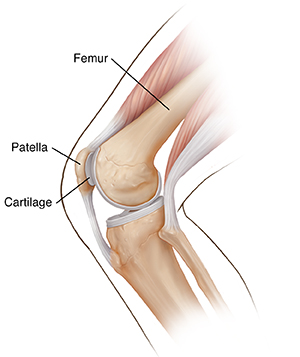Knee Pain
Knee pain is very common. It’s especially common in active people who put a lot of pressure on their knees, like runners. It affects women more often than men.
Your kneecap (patella) is a thick, round bone. It covers and protects the front portion of your knee joint. It moves along a groove in your thighbone (femur) as part of the patellofemoral joint. A layer of cartilage surrounds the underside of your kneecap. This layer protects it from grinding against your femur.
When this cartilage softens and breaks down, it can cause knee pain. This is partly because of repetitive stress. The stress irritates the lining of the joint. This causes pain in the underlying bone.

What causes knee pain?
Many things can cause knee pain. You may have more than one cause. Some of these include:
-
Overuse of the knee joint
-
The kneecap doesn’t line up with the tissue around it
-
Damage to small nerves in the area
-
Damage to the ligament-like structure that holds the kneecap in place (retinaculum)
-
Breakdown of the bone under the cartilage
-
Swelling in the soft tissues around the kneecap
-
Injury
You might be more likely to have knee pain if you:
-
Exercise a lot
-
Recently increased the intensity of your workouts
-
Have a body mass index (BMI) greater than 25
-
Have poor alignment of your kneecap
-
Walk with your feet turned overly outward or inward
-
Have weakness in surrounding muscle groups (inner quad or hip adductor muscles)
-
Have too much tightness in surrounding muscle groups (hamstrings or iliotibial band)
-
Have a recent history of injury to the area
-
Are female
Symptoms of knee pain
This type of knee pain is a dull, aching pain in the front of the knee in the area under and around the kneecap. This pain may start quickly or slowly. Your pain might be worse when you squat, run, or sit for a long time. Climbing stairs may be painful or hard to do. You might also sometimes feel like your knee is giving out. You may have symptoms in one or both of your knees.
Diagnosing knee pain
Your healthcare provider will ask about your medical history and your symptoms. Be sure to describe any activities that make your knee pain worse. They will look at your knee. This will include tests of your range of motion, strength, and areas of pain of your knee. Your knee alignment will be checked.
Your healthcare provider will need to rule out other causes of your knee pain, such as arthritis. You may need an imaging test, such as an X-ray or MRI.
Treatment for knee pain
Treatments that can help ease your symptoms may include:
-
Avoiding activities for a while that make your pain worse, returning to activity over time
-
Icing the outside of your knee when it causes you pain
-
Taking over-the-counter pain medicine such as a non-steroidal anti-inflammatory drug (NSAID) like ibuprofen
-
Wearing a knee brace or taping your knee to support it
-
Compression to help prevent swelling
-
Wearing special shoe inserts to help keep your feet in the proper alignment
-
Elevating your knee
-
Doing special exercises to stretch and strengthen the muscles around your hip and your knee
These steps help most people manage knee pain. But some cases of knee pain need to be treated with surgery. You rarely need surgery right away. You may need it later if other treatments don’t work. Your healthcare provider may refer you to an orthopedic surgeon. He or she will talk with you about your choices.
Preventing knee pain
Losing weight and correcting excess muscle tightness or muscle weakness may help lower your risk.
In some cases, you can prevent knee pain. To help prevent a flare-up of knee pain, do these things:
-
Regularly do all the exercises your healthcare provider or physical therapist (PT) advises
-
Warm up fully before exercising
-
Support your knee as advised by your provider or PT
-
Increase training gradually, and ease up on training when needed
-
Have an expert check your gait for running or other sporting activities
-
Stretch properly before and after exercise
-
Replace your running shoes regularly
-
Lose excess weight
When to call your healthcare provider
Call your healthcare provider right away if: